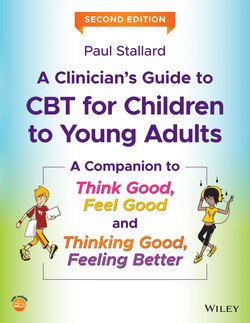Читать книгу A Clinician's Guide to CBT for Children to Young Adults - Paul Stallard - Страница 12
CHAPTER ONE Introduction and overview
ОглавлениеCognitive behaviour therapy (CBT) is a generic term used to describe a variety of interventions that focus on the relationship between cognitions, emotions, and behaviours. These interventions are based on the shared premise that emotional distress is generated by the way we think about particular events that occur. Some ways of thinking are dysfunctional and unhelpful and can lead to the emergence of psychological problems. These unhelpful patterns are maintained by attention and memory biases, emotional responses, and maladaptive ways of behaving such as avoidance.
Traditional CBT interventions focus on identifying, directly challenging, and reappraising dysfunctional cognitions and through so doing reduce emotional distress and unhelpful behaviours. Recent models, often termed third wave, focus on changing the nature of the relationship with these thoughts rather than changing their specific content. Thoughts are understood as mental activity rather than defining reality, with mindfulness, acceptance, compassion, and distress tolerance helping to minimise the emotional distress they generate.
